I don’t know about you, but I am feeling a little behind in my canning planning. If you are too, worry not! If we follow these ten simple steps, we’ll both step into preservation season calm and prepared to tackle those bushels of tomatoes and pickles and corn.
I was just chatting with my friend and mentor Margaret Roach of A Way To Garden about all this. (Listen in at her most recent podcast.) Margaret’s a vegetarian and a one-person household, so in some ways she and I put up the harvest very differently, but in other ways there are huge similarities.
We’re joining forces today with dual-giveaways (more about that later in the post) and our best suggestions for how any food preserver can face the canning season with organization and confidence.
Let’s do this.
Get Your Plan Together
1. Consider Your Goals
Some people can purely as an exercise in frugality. Some like the craft of it. Some people like the convenience of shelf-stable foods, others want to avoid BPA in cans. Some people are trying to support their local foodshed, or make sure nothing from the garden goes to waste. Some people are getting ready for zombies, other just want to control what goes into their food.
Most of us have some combination of goals that motivate our home food preservation. Consider yours. Why do you this and what do you want to get out of it?
I can, primarily, for quality, convenience and the joy of it. I like having really convenient pantry staples at the ready without having to turn to commercial convenience food. This means that I focus on versatile basics, like tomatoes and garbanzo beans.
Read more: Zombies vs. The Joy of Canning.
2. Take An Inventory
Before you start canning up dozens of jars of peach mulberry curry sauce or whatever, go spend a few minutes staring into your cupboards, pantry, garage – wherever your food storage happens. You might want to print out a larder assessment sheet for this.
Make a note of what canned items your family really eats through the year – store-bought or home-canned. For us, the big winners are always canned tomatoes, beans, pickles, stock, simple jams with zings of flavor, and pork.
Now it’s time for some hard truths. What preserved goods are languishing in your pantry, several years old and forgotten? Give yourself permission to compost those creations that you know, deep down, you will never eat.
Read More: What Foods Should I Preserve?
3. Seek Out Inspiration
Now’s the fun part! Sit down with a cup of coffee or tea and a few of your favorite canning books and the notes from your inventory. As you flip through your books, just let your food preserver’s heart run wild.
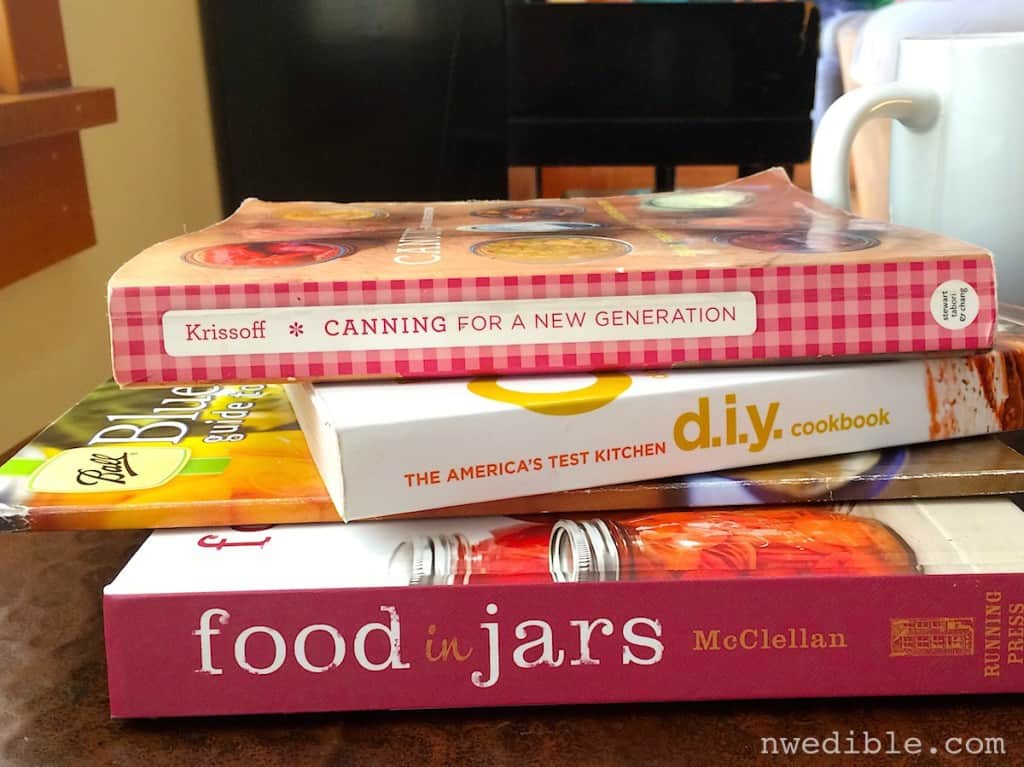
Consider your dream fantasy canning creations, holiday gifts, canning swaps and other situations in which you might give away or trade your jars. When something looks incredible, write it down or flag the page so you can easily find that recipe again.
My favorite canning resources:
- The National Center For Home Food Preservation
- [easyazon_link identifier=”B005SK6Y1Q” locale=”US” tag=”nortediblife-20″]The Ball Blue Book[/easyazon_link] (part of the giveaway below!)
- [easyazon_link identifier=”0762441437″ locale=”US” tag=”nortediblife-20″]Food in Jars[/easyazon_link]
- [easyazon_link identifier=”1584798645″ locale=”US” tag=”nortediblife-20″]Canning For A New Generation[/easyazon_link]
- And you can always [easyazon_link identifier=”1570619913″ locale=”US” tag=”nortediblife-20″]pre-order my book[/easyazon_link], which is not exclusively about canning, but which does contain many of my favorite food preservation recipes, including an awesome one for British style canned baked beans.
4. Fine-Tune Your List
Just like gardeners want to grow all the vegetables, canners typically want to can all the things. But look, we can’t. There aren’t enough hours in day or jars in the house. This is as much about editing your list as it is about scribbling things on it.
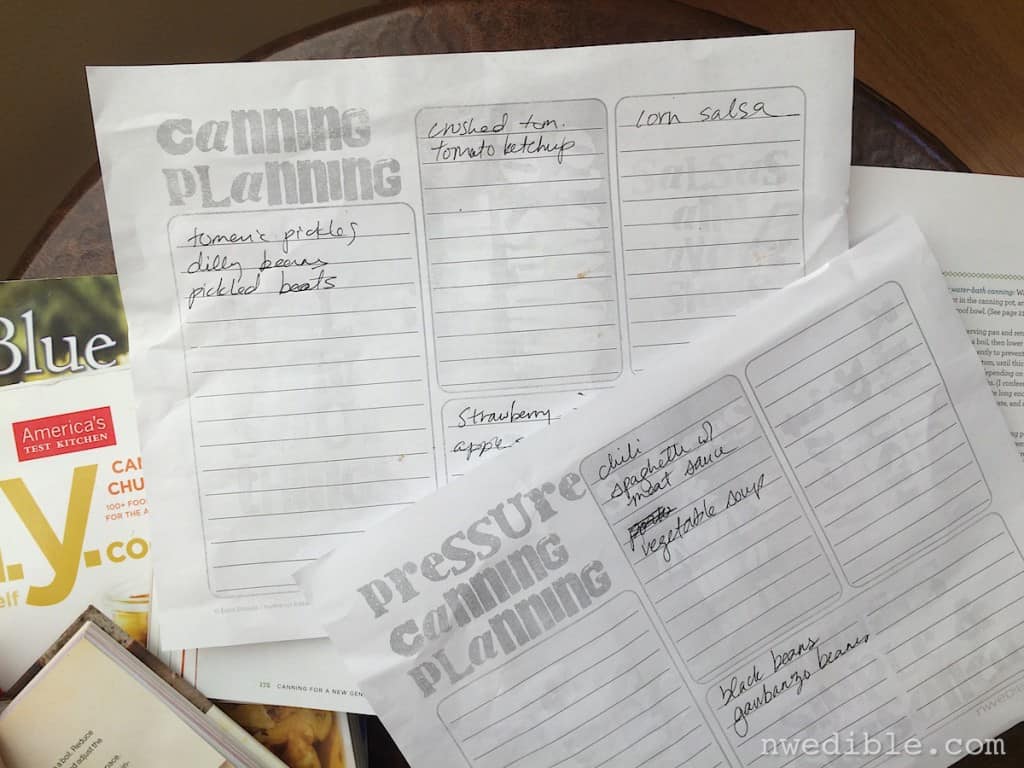
Remember your goals and inventory. Let those guide you as you make your final selections. If you like, go print out my Canning Planning and Pressure Canning Planning sheets – these will help you think about your food preservation by category so you’re less likely to decide you absolutely need 64 types of peach jam (52 is plenty).
Make sure you are selecting recipes from reputable sources that follow safe canning procedures.
5. Check Produce Ripeness Dates
Preserved food is never better than the ingredients it’s made from. We want everything to be at the peak of ripeness when we put it up. That’s when it tastes best and that’s when it’s cheapest if you’re buying.
Some produce – like cabbage – will be available locally for months and months. Some delicate fruit is only available for a few weeks. If you are harvesting your own garden you just have to be psychologically ready for the glut. If you are ordering from a farmer, pre-ordering is always smart.
If you want a specific variety of strawberry or peach from a local farmer, you may have to get even more detailed.
As an example, here’s the 2012 Eastern Washington ripening schedule of different peach varieties, from my friends at Valicoff Farms. You can see that if you are targeting, for example, the Elberta variety for your canning jar you’d better have a pretty good idea of when those peaches will be available or you’ll miss out.

Look back over your list and sanity check that you aren’t over-committed to canning projects based on produce ripening and other stuff in your life. While it’s true that late summer will always be the busiest times to put food up, there’s no reason you should attempt to squeeze applesauce into late August if you’re already planning pickles, tomatoes and peaches. As you can, stretch the process out.
Get Your Gear Together
Ok, now that you’ve got your mental game-plan together, it’s time to make sure your gear is up to snuff, too!
6. Get Your Dial Gauge Pressure Canner Tested
Get your dial gauge pressure canner tested. This is totally non-negotiable. You have to test the dial yearly. Why? Because botulism. Unfortunately, it’s become hard to find places to have the dials tested, so typically you have to ship the dial to the manufacture (Presto). This is a big pain, so if you do have a dial-only gauge pressure canner, look into converting yours to a weighted gauge canner.
If you don’t pressure can fresh vegetables (I don’t) and your canner is used more for meat and dry beans, you can probably put this off until early fall. But if you want canned corn, canned green beans or summer vegetable soup in your pantry, get on this dial-testing asap.
Additional Information: Presto Pressure Canner Service page.
If you have a weighted gauge canner, the weight itself acts to maintain the proper pressure and the dial is just a backup and indicator of when pressure has dropped to 0, so we know that it’s safe to open the canner. If you notice a difference in the pressure reading on the dial and the actual pressure as determined by the weight, you may need to get the dial tuned up but the actual pressure inside the canner should still be safe and accurate.
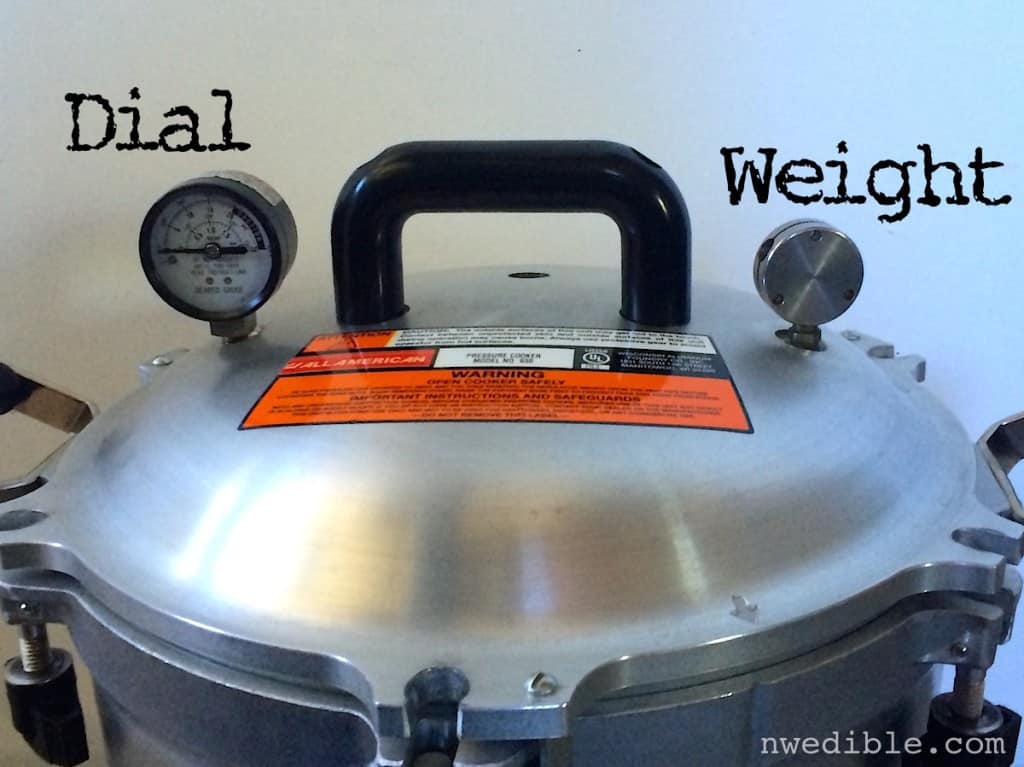
7. Assess your equipment
You do not need one of those lightweight speckled enamel canning pots. In fact, I personally really dislike those. Any pot tall enough to accommodate your jars with a couple inches of boiling water and a couple inches of head room above that is fine for boiling water bath canning. Make sure your canning pot has a rack that works, or make one yourself.
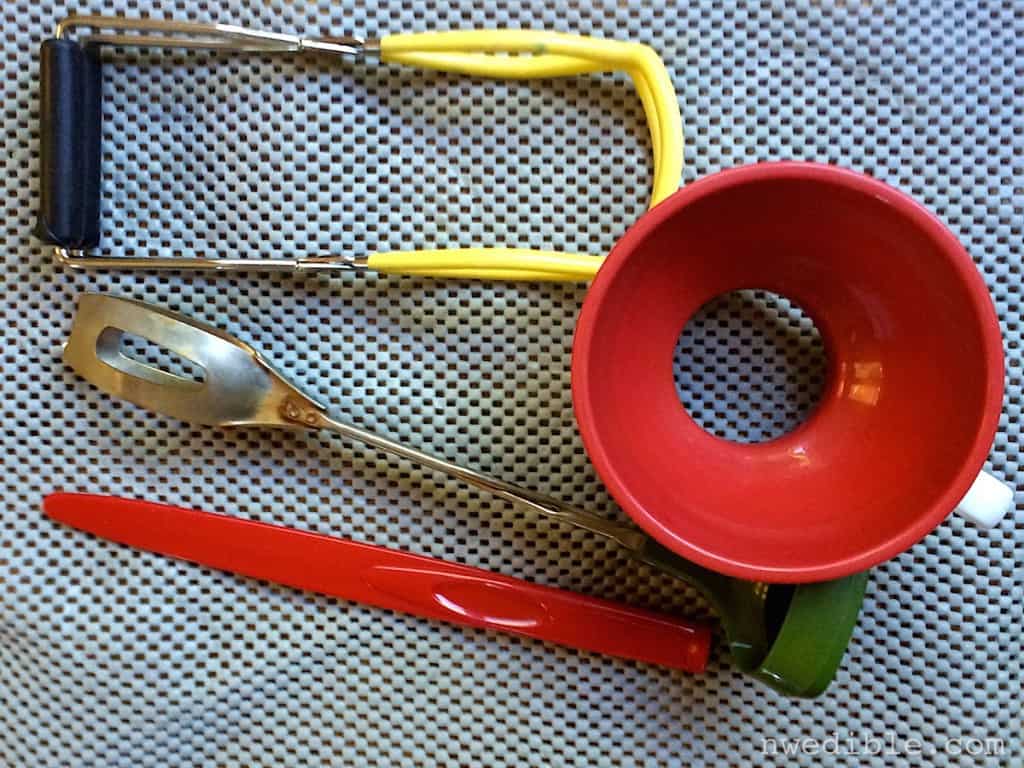
Track down your basic canning utensils and give them a dedicated home so you don’t hunt around when the canning passion is upon you. In addition to normal kitchen utensils like spoons, spatulas and ladles, you will need:
- [easyazon_link identifier=”B007QT4GMQ” locale=”US” tag=”nortediblife-20″]a canning funnel[/easyazon_link] – my favorite one is part of the giveaway.
- [easyazon_link identifier=”B000HJBFGC” locale=”US” tag=”nortediblife-20″]a jar lifter[/easyazon_link], essential for getting hot jars out of hot water safely, also part of the giveaway.
- [easyazon_link identifier=”B003UVK0S8″ locale=”US” tag=”nortediblife-20″]a magnetic lid lifter/bubbler tool[/easyazon_link] for picking up and placing just one lid at a time and removing air bubbles from jars after filling.
8. Inventory your jars and lids
Get a rough idea of how many empty jars you have and, if at all possible, sort them by size so it will be easy for you to grab what you need later.
If you are a canner, you probably always want extra jars. Sadly, now is not the time to buy a whole heap of them. The best deals on new jars happen towards the end of summer, as big box stores try to clear out their inventory. Keep your eyes peeled in several months.
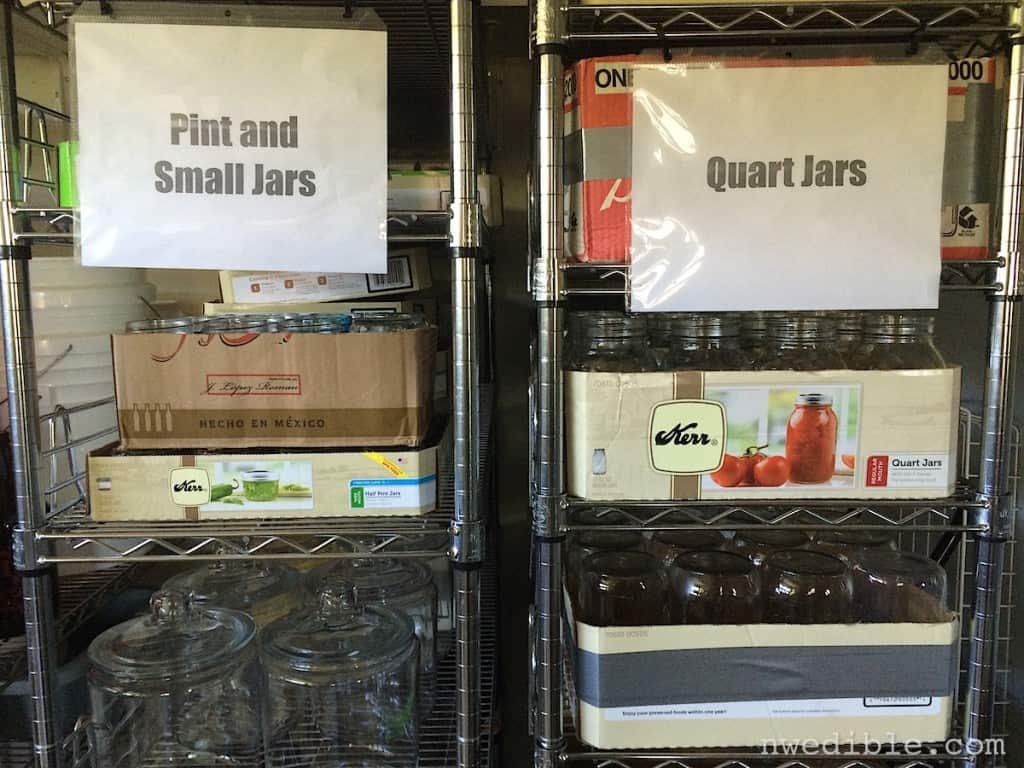
Used jars are always an option, but be warned that many thrift stores charge nearly as much for used jars without lids as it costs to buy jars new with lids! Craigslist, your local Freecycle and Buy Nothing group, garage sales and that nice old lady up the street who’s tired of canning can are better bets.
If you use reusable lids, like Tattler, or glass lidded jars like Weck, inspect your lids and gaskets carefully for signs of wear and tear. U.S. food safety recommendations are to treat rubber gaskets used for canning as single-use items, but according to Marisa at Food In Jars, in Europe gaskets are typically used until they begin to stretch. I follow U.S. food safety regulations.
If you use two piece lids, check to see how many boxes of flats you have. If you are a large-scale canner, it might make sense to [easyazon_link identifier=”B00I17LC92″ locale=”US” tag=”nortediblife-20″]buy lids in bulk[/easyazon_link]. In any event, do keep your eye out for good deals on lids in grocery and hardware stores.
While we’re doing this, let’s go through our rings. If you are like me, you probably have 17 times more rings than will ever need. Remember, after the jars cool and set their seals, it’s best to take off the rings and store the jars with just the sealed flat.
Go through your rings and pull out any that are rusty or no longer perfectly round. Upcycle, recycle or donate extra rings.
9. Stock up on basics.
There are some items that I know I will use a ton of throughout canning season. Vinegar, kosher salt, pickling salt, organic sugar and citric acid are my must-haves for jamming, pickling and processing my way through hundreds of pounds of seasonal produce. Your basics might also include pectin and bottled lemon juice.
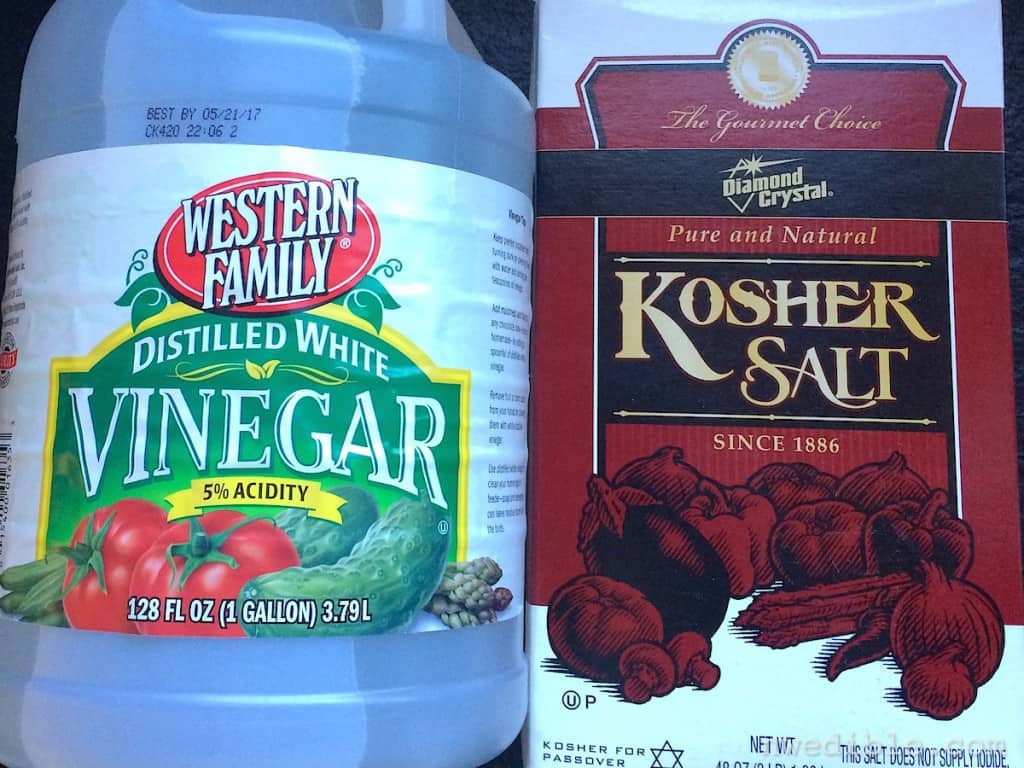
Stock up on the basics you know will be used in your preserving. Vinegar, salt and sugar don’t go bad, and it’s such a pain to have to run out to the store if you find yourself suddenly out of apple cider vinegar. If you can a lot, all these things are available for far less in bulk at stores like Costco.
Check through your spices, too, and make sure you’re good for dill seed, black peppercorns, cinnamon, pickling spice, or whatever spices you know will be used. I highly recommend buying your spices in bulk. Fresh spices mean tastier preserves!
10. Don’t Go It Alone
While they aren’t technically “gear,” one of the most useful tools in your canning kitchen is a productive friend by your side! It’s just more fun to do this kind of work with another person, so text your friends, call your mom, email your neighbor and see who might be up for an afternoon of pickling or jamming.
Alternatively, if your kitchen can’t handle the chaos of multiple canners at once or you just prefer to can in meditative contemplation, throw a canned food swap after the jars cool and the seals set. A canning swap is like the late summer equivalent of a holiday cookie swap, and is a fantastic way to get more variety in your preserves.
Just, do me a favor, make sure anyone you are swapping jars with follows the same high modern safety standards that I know you do, and can confidently and proudly explain how their product was made.
The Giveaway!
Margaret and I are each giving away a kit of canning gear that will help you get started. So, enter here and then make sure you go visit A Way To Garden to enter on her site. Twice the possibility of winning! See, I told you canning was better with friends.
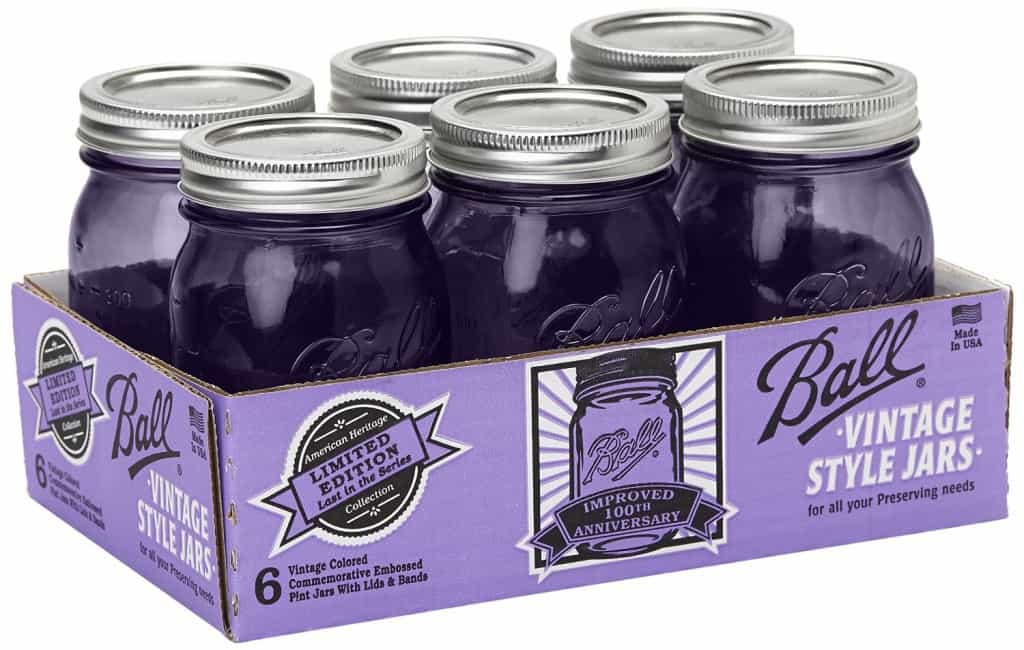
Here’s what you’re entering to win:
- The recently updated [easyazon_link identifier=”B005SK6Y1Q” locale=”US” tag=”nortediblife-20″]Ball Blue Book[/easyazon_link]
- 1 Case (6 jars) of the new [easyazon_link identifier=”B00ODC255Y” locale=”US” tag=”nortediblife-20″]Ball brand Heritage Purple Canning Jars[/easyazon_link] in Pints
- 1 Case (6 jars) of the new Ball brand Heritage Purple Canning Jars in Quarts
- 1 [easyazon_link identifier=”B000HJBFGC” locale=”US” tag=”nortediblife-20″]Norpro Jar Lifter[/easyazon_link]
- [easyazon_link identifier=”B007QT4GMQ” locale=”US” tag=”nortediblife-20″]My favorite canning funnel[/easyazon_link]
- A [easyazon_link identifier=”B007QT4GNU” locale=”US” tag=”nortediblife-20″]specially designed canning scoop[/easyazon_link], to get that jam into the jar.
To Be Entered
Just answer this simple question in the comments section below: “What one food preservation topic do you wish you knew more about?”
The Fine Print
Open to US residents of the United States only.
Contest closes 8 pm Pacific time, Sunday, June 21th 2015.
Winner will be notified by email and shall have 48 hours to respond to claim their prize.
Ball Blue Book and Ball brand Heritage Jars provided by Jarden Home Brands. All other items provided by NWEdible (me!).
And don’t forget to go enter over on Margaret’s site, too!
Good luck!
2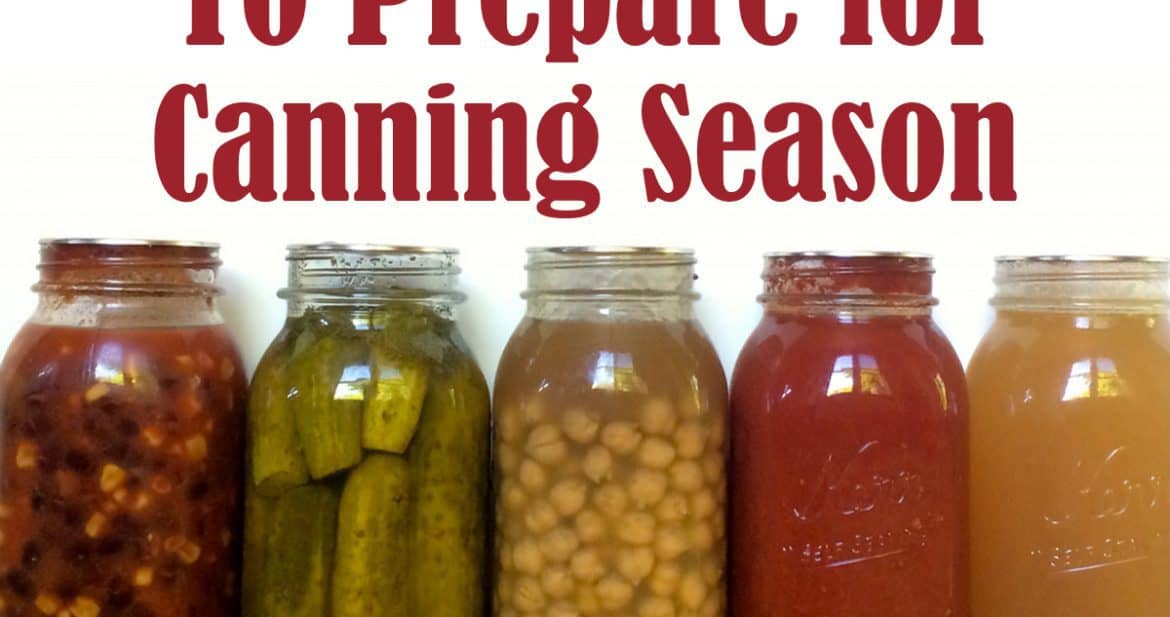
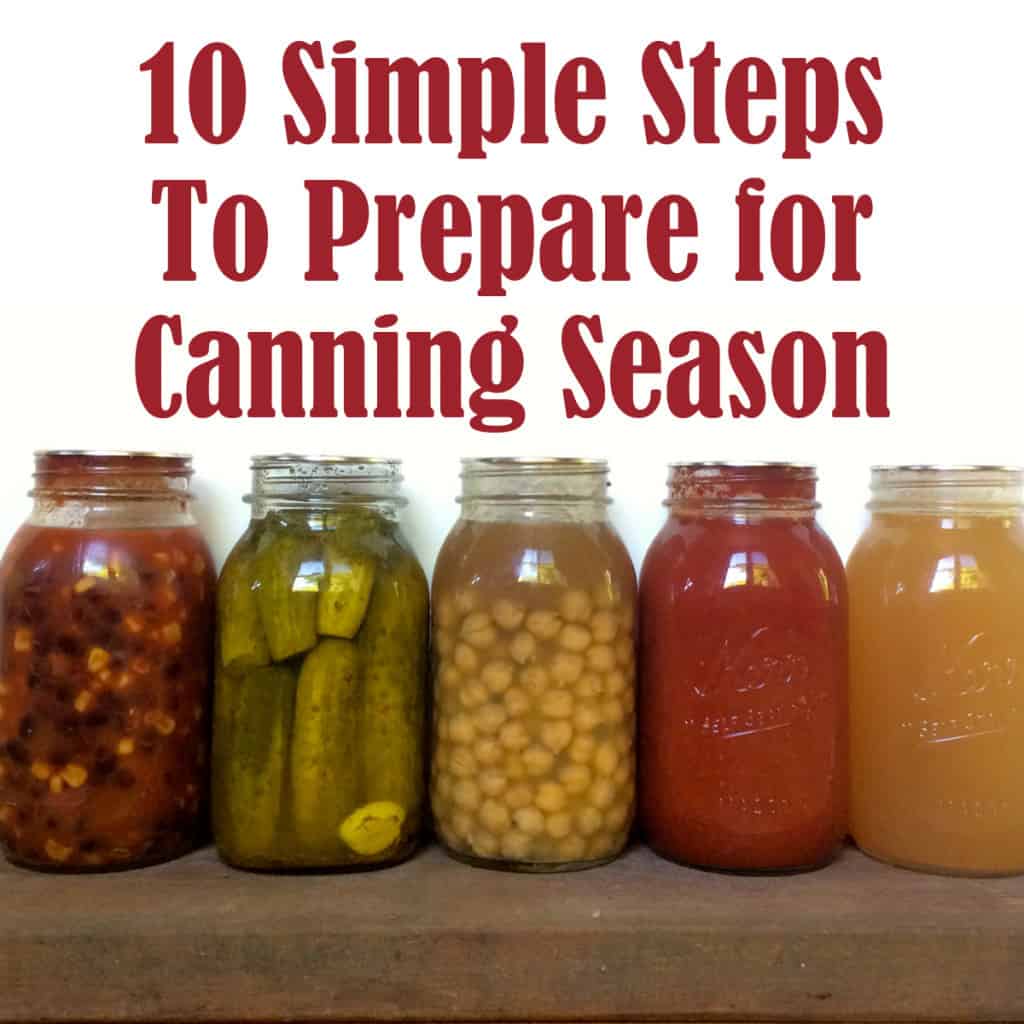
I love love love the book Food In Jars. So glad to see it on your shelf as well! As for canning questions, I would love to read more about ways to use the tasty stuff we can. We see great recipes and try them but aren’t always sure afterwards what to use this fabulous salsa or chutney or fill in the blank with. I need more confidence!
Making pectin from apples, and also pressure canning.
My biggest canning problem is time! And heating up the house. Oh, how I would love an outdoor kitchen and no full time job. I am going to do more green/wax beans this year (canned 24 pints last year, they lasted 2 weeks after the last batch), more tomatoes for salsa, and I’m going to experiment with using ACV to preserve zucchini chunks that I can then rinse off to use in a vegetable mess during the winter. Hopefully that won’t turn to mush. and I usually add a bit of ACV or other acid to the pot, so it won’t be out of place once rinsed. So basically “pickling” with no additional spices in it.
I also would like to know more about preserving fruits without using sugar. I have stumbled upon mostardas and have made a bunch out of pears, but is there any other flavor combination that would be good?
Freeze-drying, and the best way to keep dehydrated foods. They lose color, and I assume nutrients, over time. Should I vacuum-seal them in packets instead of putting them in jars? What preservation method has the longest shelf life?
I have some frozen pesto left in the freezer from last year’s basil crop. Also a jar or two of tomato sauce.
Canning in general, but particularly salsa, stews, soups, and sauces
Charcuterie! We are doing pretty good with canning veggies but I would like to take advantage of when meat goes on sale and preserve it.
More ways to can apples besides applesauce! We’ve got thousands of apples coming in and I’m envisioning a hundred jars of applesauce. And possible food fatigue. 🙂
looking forward to some fresh strawberries. Never can have too many 🙂
I wish I knew more about canning meat/ meat products (like stews, etc). I am new-ish to canning, have only done it independently the past 3 years, and only the past year with a pressure canner, so I am upping my skills, but I would really like to try to can things like chili as well.
I have only one jar of fig jam saved from last year’s canning. It is great on scones for brunch and company is coming the end of June. I have put up two batches of rhubarb jam and soon will be putting up strawberry preserves, then currants and blueberries and then on with the raspberries, all from my gardens. I have been freezing small packages of spinach, collards and kale for use in morning smoothies. The giveaway is fantastic!
Just getting into pressure canning, so would love to learn more about it. University of Alaska has lots of info and a demo on canning salmon, but that’s all I’ve used it for. Also would love to learn about canning fruit with honey syrup.
Knowing how to freeze vegetables so they don’t go mushy would be wonderful.
Spring is a joyous time of year. I’m awaiting green beans, eggplant, a huge variety of tomatoes and peppers, plus much more! I’ve still a few things in my pantry – pickled green cherry tomatoes that I refer to as Tomolives, a few jars of apple sauce and one lonely jar of canned tomatoes. My eggplant pasta sauce is on my mind – hope to make many jars this year. It’s sought after by friends and family alike! And my pride – Darn Good Dilly Beans. I never can make enough. I hope Margarets count me in on the giveaway – very exciting! AND I’m definitely signing up for your newsletter!
Pressure canning. I have slowly learned how to use a water bath canner but pressure canning is a mystery.
Are there electric pressure canners? Options for pressure canning with a glass top stove. I’ve already replaced one glass top that cracked and so am not comfortable canning on it again, even with water bath, as it’s just too heavy. I’ll get the Ball electric canner for water bath canning if there are no options for electric pressure canning at this time. Thanks!
I tend to freeze stuff for me (my household is like Margaret’s, but with meat and not much bread/pasta), but I small batch can for gifts. I’d like to do a pickled mix of vegetables, they look lovely in the jar, or maybe pickle green beans or cornichons as they are good cocktail snacks. Thank you for the giveaway!
Which topic would I like to know more about? Hmm. Perhaps canning soups. I’ve only done chicken soup but would like to figure out how to can others. Thanks!
I wish I knew more about canning meats. I grew some scary stuff once in canned pork stock so now I’m terrified.
I would like to learn more about canning soups – since there are so many ingredients – I wonder what is good to include in them (veggies?) and what gets gross (noodles, meat?).
Pressure canning, especially meats/broths. I have a pressure canner (a Christmas gift) but have been too chicken to use it yet.
Pressure canning
I totally wish I knew more about pressure canning. And I wish there were more recipes for pressure canning. All I’ve ever pressure canned is stock, and I really want to put up a variety of soups. I’ve heard you’re able to put up just about any soup recipe in a pressure canner (minus a few specific dangerous ingredients), but I don’t really have any good soup recipes to start with.
Thanks for the great giveaway!
I would love to learn how to keep my pickled veggies from getting soggy!!
Pressure canning… I do some but it’s still pretty intimidating (i.e. times if you are canning soup vs. one ingredient.)
Another check-in by someone who can waterbath can in her sleep but would like to learn about pressure canning. The two biggest areas where I can improve my intake from our foodshed is frozen meat (easy) and canning dried beans (scary).
I just bought an All American pressure canner (based mostly on your recommendation actually!) so a step by step and maybe some soup and meat canning recipes would be stellar! The manual is good but just not the same, you know?
What one food preservation topic do I wish I knew more about? Pressure canning for sure. I need to learn how to pressure can for storing stock.
I have some limited canning experience, but passionate about the food items I really like canned (hello dilly beans). I’d like to know more about canning fish. I’ve never come across anyone personally who cans fish, and I haven’t seen a recipe that looks really enticing. I love fishing and being on the water and I would definitely be more interested to learn mroe about the process of cannign fish.
I’d like to know how to make my own Kim Chi. I’m glad Margaret ‘introduced’ me to you and your great blog! I’ll be referencing it this summer for tips and info.
-Bridget
I would have to say Pickling ! I have made jams and jellies. This year I planted many cucumbers in hopes of learning how to make pickles. My mother in law and I do this together and it is one way we get bond. It is so much easier and fun with two people, She has actually pickled watermelon rind for use in fruit cake, but neither of us has attempted pickles . I am pretty excited to give it a go.
My biggest fear in canning,….canning anything with tomatoes terrifies me.
Pressure canning of meat –
Pressure canning! I haven’t been brave enough to try… yet.
Pressure canning.
I’m 100% a fruit canner, so I’d like to know more about vegetable canning.
BEEF JERKY!!! <3
Pressure canning!!! Ahhh!
Canning meat is something I’ve not yet tried… I’d like to see more about that 😉
I’m still working on finding the perfect strawberry sauce recipe for my pancakes in winter!
Most excited to try freezing cherry tomato, to accompany the canned plums.
My biggest question is for which fruits lend themselves better to freezing over jams. I think those that end up getting cooked or need sugar (rhubarb, tart bluberries, sour cherry) are fine as jam, while those more naturally sweet (peaches, strawberries, apples) are better for freezing. What’s your guide;line?
Definitely pressure canning! I have 2 but pressure just makes me nervous >_<
Preasure canning with meats and fish scares me.
Pressure canning, this is will be my first year of doing it! I love water bath canning and freezing my harvests! So excited for canning this year but also a little worried about pressure canning!!
I wish I knew more about pressure canning. I’ve only used my pressure canner a few times.
I have canned fish, a long time ago. I would like to learn to can meats.
Pressure Canning.
I wish I knew more about making jam. I tried making it with my extra strawberries and it turned out more like syrup than jam.
Pressure canning scares me too! I had an old pressure canner and sold it 🙁
I would love to know more about canning fermented anything! The whole canning process seems daunting, but I am going to try it this summer 🙂
Water bath canning. I’ve read and read but never actually done it. I’m chicken, AND it’s about 150 degrees here in August when the good stuff is ready to go!